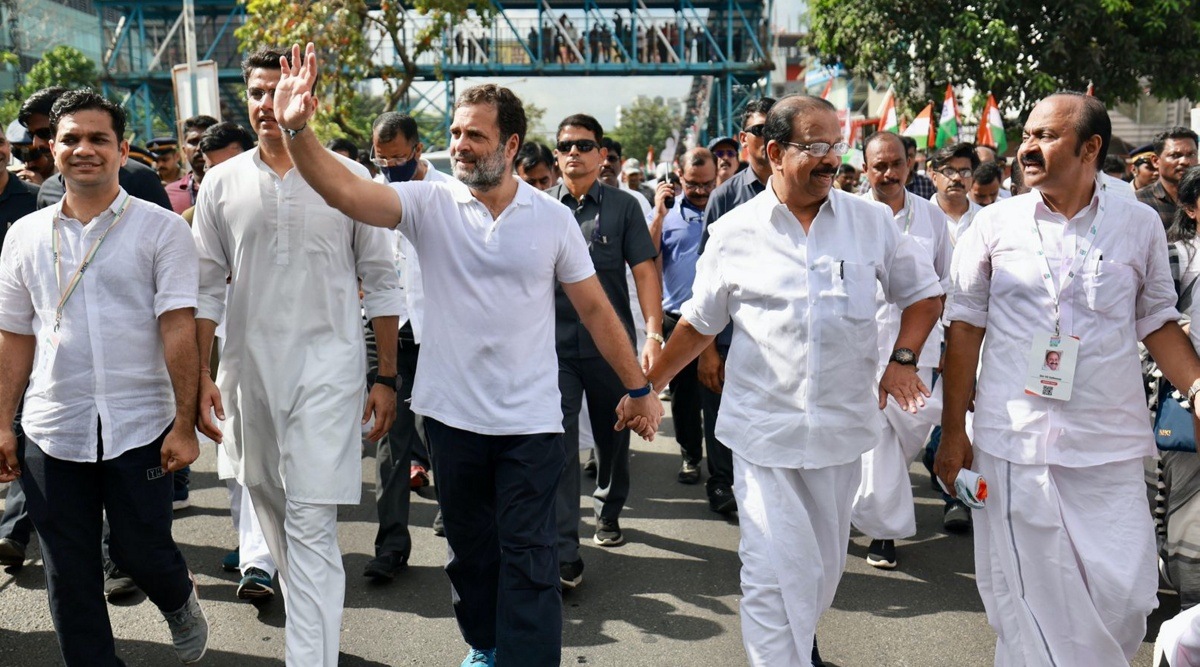 The Congress' metaphor of the Hindutva and RSS perhaps intends to project the Sangh’s divisive image. But those who understand the public psyche know that this perception is changing fast even amongst those who used to subscribe to this stereotype of RSS and Hindutva politics at one time. (PTI)
The Congress' metaphor of the Hindutva and RSS perhaps intends to project the Sangh’s divisive image. But those who understand the public psyche know that this perception is changing fast even amongst those who used to subscribe to this stereotype of RSS and Hindutva politics at one time. (PTI)During the Congress’s Bharat Jodo yatra campaign, some of the party’s members tweeted an image of the “khaki half pant on fire” – the garment has been a stereotypical metaphor for RSS and Hindutva politics in secular discourse that has occupied significant political space for decades. Times have changed, the RSS has changed but the metaphor has remained fixed. One cannot see RSS cadre in khaki half pants in their Shakhas today. They wear trousers of badami (brown) colour.
The Congress’s metaphor of the Hindutva and RSS perhaps intends to project the Sangh’s divisive image. But those who understand the public psyche know that this perception is changing fast even amongst those who used to subscribe to this stereotype of RSS and Hindutva politics at one time. And, a large section of people and communities see the RSS and Hindutva politics in ways quite contrary to the monolithic stereotype that Congress still uses.
This image of the Sangh was constructed by a section of people in the post-Partition context. This image was circulated amongst a section of people with its accompanying connotation of communal violence. In my recently published work, Republic of Hindutva, I have tried to document multiple other images that were popular among various social communities in our society.
In this changed context, who will subscribe to the old stereotype? Such an image of Sangh may certainly not appeal to a larger section of people in India. By attacking an unreal image, the Congress and other political parties don’t engage with the real Sangh. This gap between the metaphor and reality contributes to reducing the efficacy of Opposition politics.
We interviewed people in the hamlet of rat pickers (Mushhar Basti) near Varanasi where the Sangh is doing Kar Sewa (social service). Our interaction revealed that marginal rural communities view the RSS very differently from what the Congress-led secular discourse would have us believe. Similarly, among Sapera bastis (hamlet of snake charmers) near Shankargarh district in Prayagraj, we found that the Sangh has acquired an image entirely different from what the Congress has been propagating. We are not talking of two or three hamlets, but several villages, basties and purvas (small hamlets) with multiple images of Sangh that have been formed as a result of the activities of the organisation amongst these people.
Its use of such moribund methods may not get the Congress new supporters, it could also contribute to antagonising those who see the Sangh as the protector of the Hindu cause. We know a section of the Indian public looks at the RSS’s Hindutva and Hinduness as synonymous. The campaign by the Congress and other Opposition parties could antagonise a section of the Hindu public, who are not hardcore and push them into the arms of the BJP and Hindutva. Moreover, even among Hindutva followers, there are layers of consciousness. Based on my long association with marginal communities and understanding of public political consciousness, I can assert with some conviction that the Congress’s attack of the Sangh, BJP and Hindutva politics will be counterproductive for the party. While responding to such attacks during the Bharat Jodo Yatra, RSS’s Sah Sarkaryawah Manmohan Vaidya said that Sangh is in favour of any campaigns which want to unite India. Still, it can’t be one with any kind of hate element, cleverly subverting Congress’s allegation.
Fire is an overused symbol in the country’s political discourse. In everyday politics, it reflects sudden, unplanned violent protests, usually used by leaderless masses. The fire also represents ultimate destruction, the “swaha” of hate and violence. This may be a politically appropriate symbol but associating it with the RSS could make the message abstract – one that may not touch the heart and minds of people and instead end up confusing them. I remember a couplet of a saint-poet who said, “Fire also needs rest. It becomes tired of burning things. Its wrong use annoys fire”.
The writer is professor, Govind Ballabh Pant Social Science Institute, Allahabad